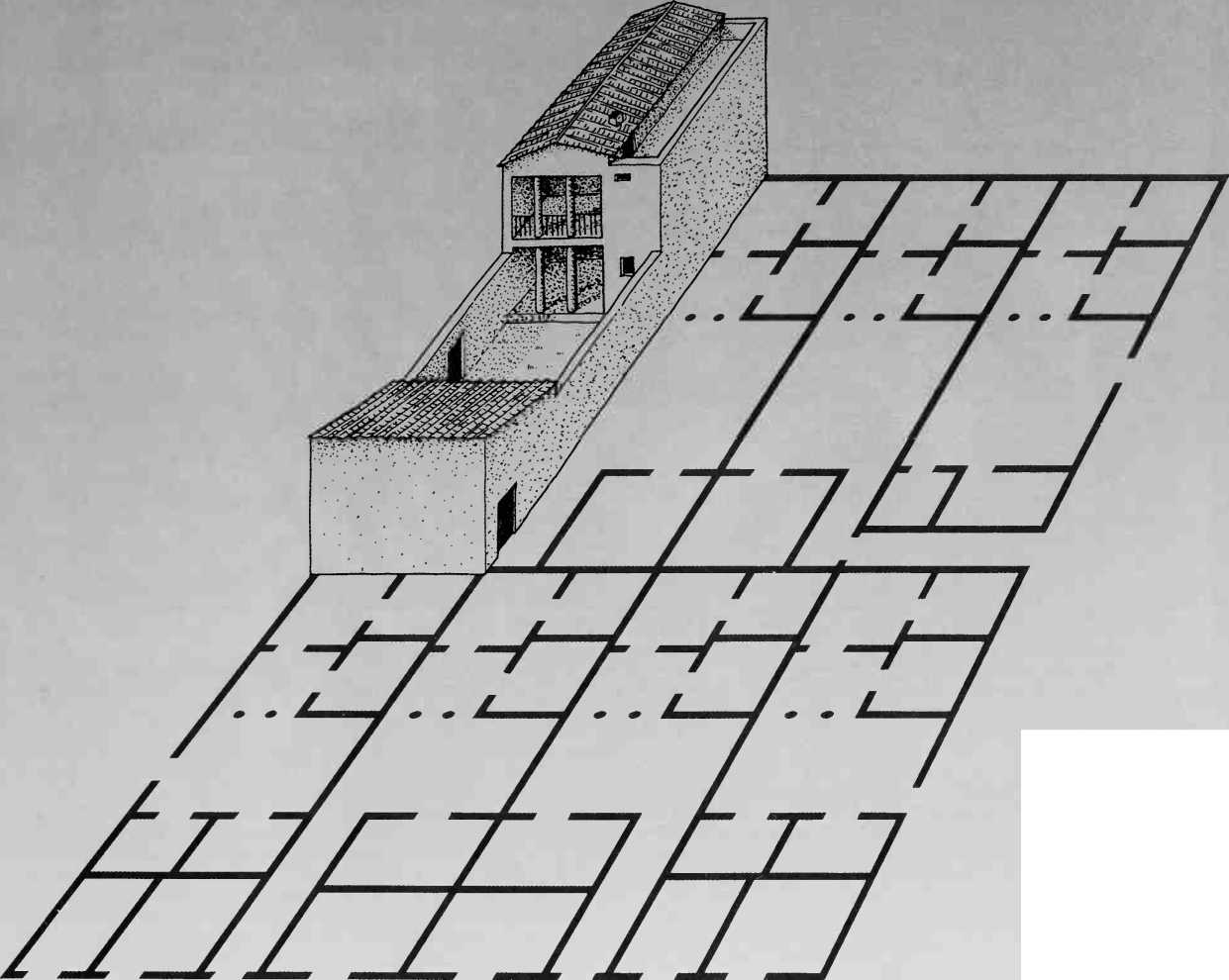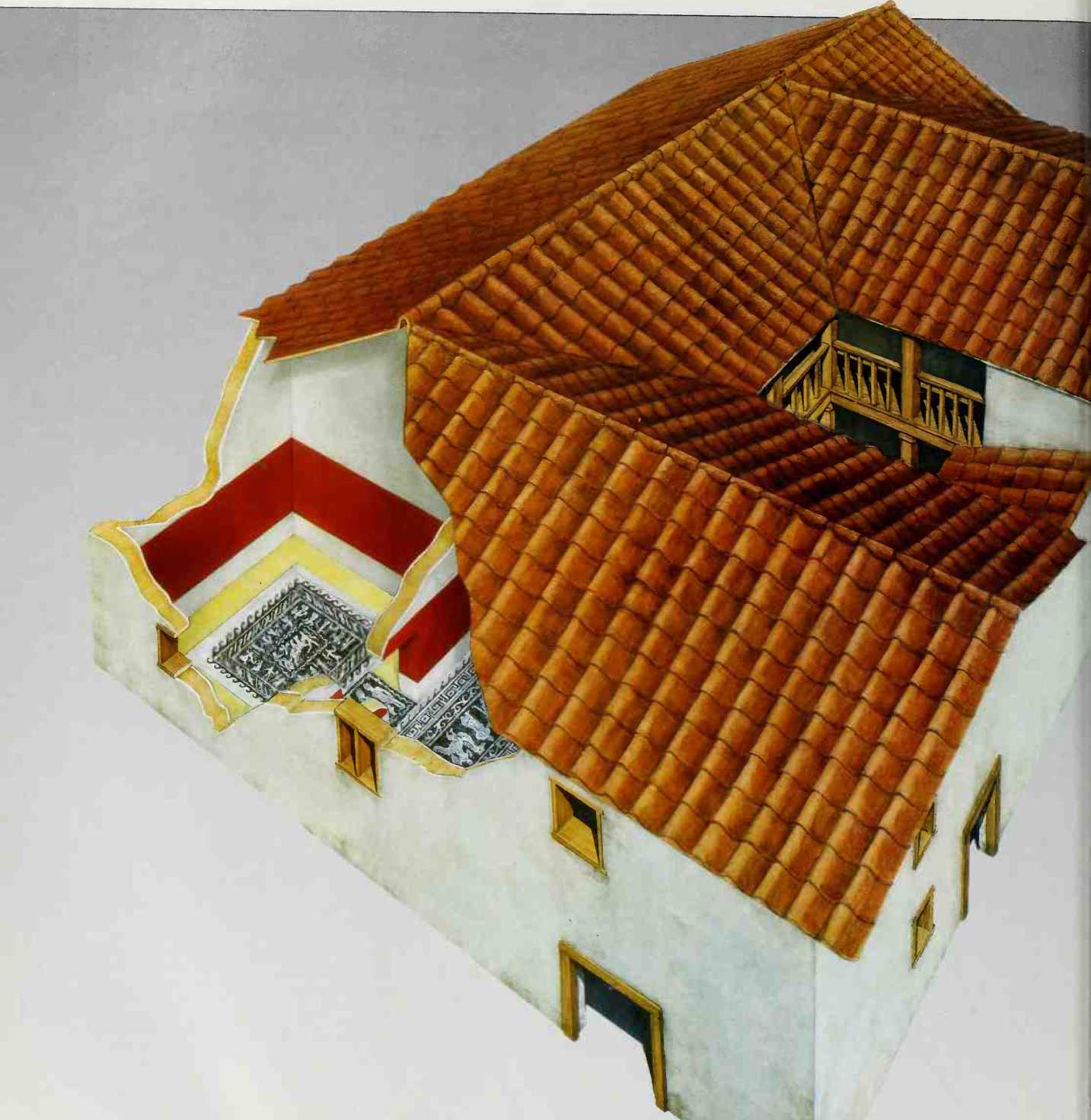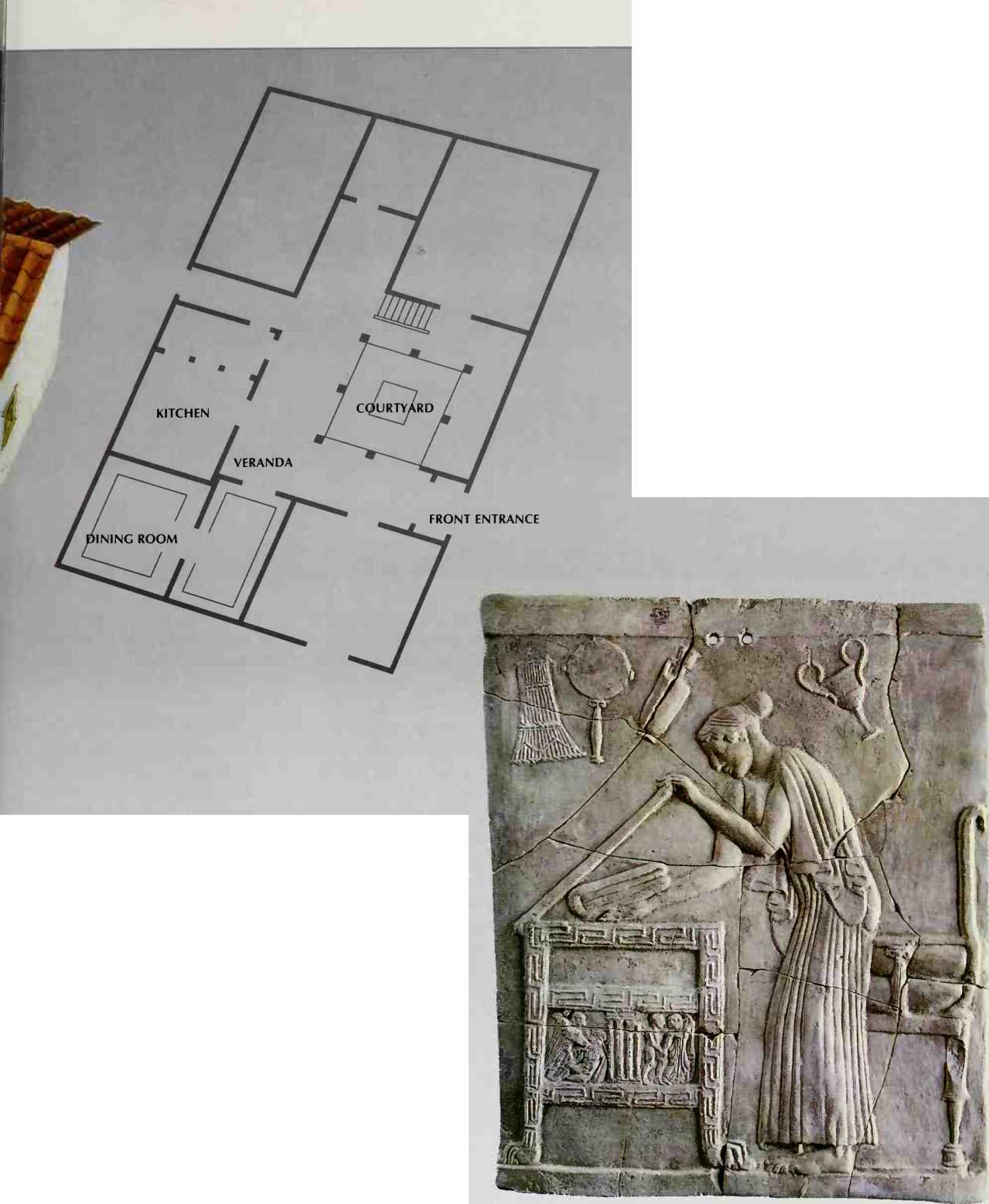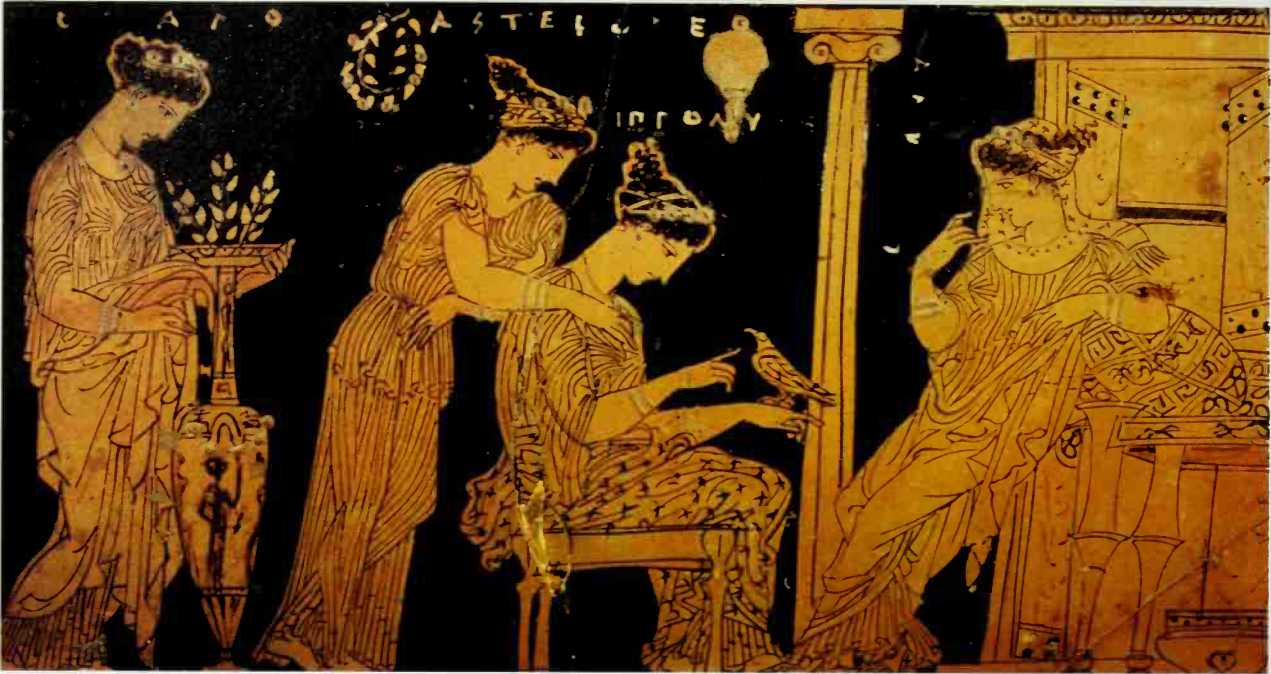Because the ancient Greeks—the men if not the women—lived mostly outdoors, and because private life was secondary to the public world of temple, theater, and stadium, their houses were rarely elaborate. Instead they were simple units providing shelter for work and leisure but little else—for water, inhabitants had to walk to a public fountain house; for latrines, they used a back alley or a communal cesspool.
Most urban houses were packed tightly
Together In blocks, as shown In the reconstruction below of dwellings in the town of Priene on the coast of Asia Minor. But the straight external lines of each block hid a wealth of internal variety: The buildings here, for example. Include stores and artisans' workshops as well as private homes. The rich could afford more space, as evident In the reconstruction overleaf of a house in the mainland town of Olynthus, but they enjoyed no additional comforts.

In each two-story dwelling in this maze of interlocking passages and courtyards, the general-purpose living room is entered from the south porch. Other rooms are used for washing and for sleeping, and each house has rooms reserved for males and females respectively.



A fifth-century-BC terracotta relief shows a woman placing a neatly folded garment in a chest; hanging on the wall behind her are a basket, a mirror, and two vases. Chests, beds, tables, and chairs or stools constituted the basic furniture of Creek houses, although only the rich could afford the elaborately decorated examples shown here. These items vere often covered with textiles woven on the household loom, which was also used to make the family's clothes—simple, rectangular pieces of cloth that could be draped on the body without the need for cutting to shape.
As shown in the accompanying ground plan, this spacious family house built in the late fifth century BC comprises a series of rooms clustered around a small cobblestone courtyard that probably contained a water cistern and an altar. The cutaway section reveals a mosaic of black-and-white pebbles on the floor of the dining room. The walls are built of sun-dried bricks covered with rough plaster; the external windows and doors have timber frames, and the structure is roofed with terra-cotta tiles.

And of unfamiliar social customs, that expressed different relationships to the outside world and among the family members from those they were used to. Most likely, however courteous the hosts, the Americans looked forward to eventually returning to their native land.
The stone palace to which Homer had Odysseus return at the end of his travels was an early literary version of a modern Hollywood film set: a fictional edifice larger than life in every respect, yet still recognizable and appealing to its audience. In real life, conditions for many contemporary Greeks were hard: Their lives were a constant struggle to produce enough food to support themselves against the handicaps of almost-unarable land, barren hillsides, and hot, rainless summers. The way most Greeks lived was reflected more realistically by another poet who wrote more than a century later than Homer. Hesiod, in his poem entitled Works and Days, described a harsh world in which famine was a constant threat for the poor farmer; Hesiod talked in longing terms of a golden age when life was comfortable for all. Part of the appeal of Homer's poem lay in a similar nostalgia. Odysseus's residence embodied folk memories of the palaces of the Mycenaean kings who had ruled in southern Greece in the last centuries of the second millennium BC. Homer was also concerned mainly with the exploits of the aristocratic warrior class—Achilles, the hero of his poem the Iliad, imagined the life of a landless laborer as the most miserable existence possible. Yet that existence, rather than the lives of the noble warriors, would have been closer to that of Homer's audience. The allure of Homer's description of such grand settings as Odysseus's palace depended on the stark contrast between the glamour of myth and legend and the meager dwellings to which his listeners returned after the tale was told.
Most people in Europe at the beginning of the first millennium BC lived in simple square, rectangular, or round huts built of wood; stone was employed only in parts of southern Europe and Scandinavia where timber was scarce. Many among them were skilled in working these materials, and also in making pottery and in smelting iron to fashion tools or weapons. The majority lived off the land, growing just enough crops to feed themselves and their dependents. But the impact of cities—pioneered in Mesopotamia and Egypt around 3000 BC—was beginning to be felt, and it was the development of urban ways of life in the Mediterranean region that was to promote advances in domestic conditions far exceeding anything even Homer had imagined. Only cities offered an alternative to backbreaking labor on the land; only cities enabled ordinary men and women to invent for themselves more varied, comfortable, and rewarding lives. ,
In a wealthy Athenian household of the fifth century BC, women relax in their secluded quarters, where the only males admitted were the master of the house and other close relatives. This scene forms part of the painted decoration of a terra-cotta epinetron, a leg shield placed over a woman's thigh as she separated hanks of wool from a washed fleece for spinning. The tall vase on the left is of a kind that was used to heat water for a marriage bath, indicating that the epinetron was probably made as a wedding gift.
In Greece, as Iron Age villages coalesced into larger centers, these urban concentrations further developed into the key institution of the classical world—the polls, or city-state. In its heyday, between about 600 and 400 BC, the city-state spawned most of the extraordinary intellectual, cultural, social, and political achievements of Greek civilization. In turn, these achievements directly shaped all of Western civilization until the influence of Rome gave way to Christianity in the middle of the first millennium AD. For more than ten centuries, a great many features of everyday life remained largely unchanged.
The polls rolled into one all the attributes of village, city, community, country, and nation-state. At its heart was a town or small city, probably surrounded by a defensive wall, but the polls also comprised the surrounding hinterland and outlying villages. Thus the polls of Athens, for example, encompassed the whole district of Attica, an area of some 965 square miles, and its population by around 400 BC may have numbered as many as 350,000.
By the fifth century BC, Athens was effectively the cultural capital of Greece. Yet there were many other important and distinctive poleis. Some—such as Corinth, strategically placed on the neck of Peloponnesus—were commercial and trading centers. Others grew up around the manufacture of special products. Sparta, a law unto itself, was distinguished by its exclusively military character; Every citizen was a soldier and all other callings were forbidden. In fact, Greece was not a single nation at all: Hellas, the word that referred to the Greek mainland territories as a whole, had emotional but no political meaning, for each polis functioned as an independent state, as often as not at loggerheads with its neighbors.
For all their differences, most poleis shared a similar plan. Outside the walls were cemeteries, sacred groves and shrines, and small farms and gardens. Those closest to the walls were owned and worked by citizens living within; farther away would be the plots of hard-working peasant farmers. Inside the walls, the traditional heart of the polis was the acropolis, a defensive retreat on a convenient hill that frequently also boasted a temple or two, especially to a deity of local importance. The hill was also a favorite place for the open-air Greek theater, the slope forming a convenient base for the banked seating. But the social focus of the entire community of the classical polis was the agora, a large open space in which were concentrated all of the many facets of Greek public life. It was often approached down a flight of steps that doubled as seats for an assembled crowd.
The limitations of Greek technology meant that large buildings like assembly halls were rare. But the lack of indoor gathering places had little effect on everyday life.
Because from first light until dusk the Greek citizen lived largely out-of-doors. All of his daily activities—meeting friends, shopping, exercising in the gymnasium, attending religious festivals, running the affairs of the polis—took place in the open air. The warm climate of Greece made possible something that was wholly impractical in other parts of the world: Public affairs were conducted in public space, not in the seclusion of a council chamber or chieftain's hut.
Greek cities were always compact, usually for defensive reasons, and housing districts were squeezed into the space left around the all-important public areas, graphically reflecting the priorities of Greek thinking: the political and social first, the domestic last. The restricted city sites produced the incidental effect that different classes lived closely together; there was insufficient space to allow the rich to escape to exclusive districts.
Houses were built in blocks, typically approximately 100 feet deep and 150 feet or more long, and were undistinguished from the outside. Most ordinary houses were constructed of dried mud bricks reinforced with timbers, and they were joined to their neighbors in continuous rows. This configuration could have unexpected benefits: In 431 BC, according to the historian Thucydides, a contingent of enemy soldiers infiltrated the central Greek city of Plataea by night; relaxing in an open square, the invaders were overcome by Plataean defenders who had secretly advanced "by knocking holes through the party walls of the houses, that they might not be seen walking through the streets."
Each home usually had only one entrance, commonly facing south, which in all except the smallest houses led into a small cobbled courtyard. Here there would be a domestic altar, and usually a large earthenware pot or stone cistern for water

A Roman bone hairpin (right) bears the image of a woman with a layered hair style of a kind worn by many highborn ladies for formal occasions. Such creations often required the addition of false hair— black from India and blond from Germany were especially favored. A third-century Roman marble relief (left) shows a woman attended by her hairdresser while servants hold a mirror and jars of perfume and water.

Storage. External windows were small and high up in the walls of the rooms. These were often fitted with wooden shutters, which, in the deforested lowlands of Greece, were considered precious possessions. When an Athenian citizen moved from a house, he took his doors and shutters with him.
Upper stories were reached by an external staircase and probably housed bedrooms under their pitched roofs of terra-cotta tiles. The removal of these tiles was a favorite method of housebreaking; another was to tunnel under the very shallow wall foundations, a practice celebrated in the Greek word for burglar, which literally translates as "wall excavator."
The often dull and uniform external appearance of Greek houses was deceptive. No two had the same internal organization. As in all times, the rich were able to command more space, and hence might have a dozen rooms instead of the more usual five or six. They also had more scope in the choice of materials and decoration: stone instead of burned brick, cemented or even mosaic floors instead of tamped earth, and painted walls. But even the homes of the affluent were sparsely furnished: One room suitable for entertaining guests might be lined with simple benches, another would contain a bed, yet another a brazier or stone hearth.
All Greek homes had a separate gynaeceum, or women's quarters. Depending on the size of the house, this consisted of one or more rooms set apart from the guest rooms and the more public area at the front of the house. The separation was nominal rather than the result of special walls or locked doors, but its effect was the same. One reason for the gynaeceum might have been to monitor the behavior of the female slaves who lived there—and to control male access to them. But its principal inhabitant was the woman of the house. Here was where the cloistered wives of Greek citizens were expected to spend a large part of their time.
Almost without exception, citizenship—which in a democratic polis such as Athens included the right to elect and serve as leaders, and to sit in the public assembly—was open only to freeborn men. Women had to content themselves with being the relatives of citizens, enjoying a social status similar to that of their fathers or husbands—but with no political rights. The lot of slaves was even more circumscribed: They, along with beggars, were at the very bottom of both the Greek and the Roman




 World History
World History









